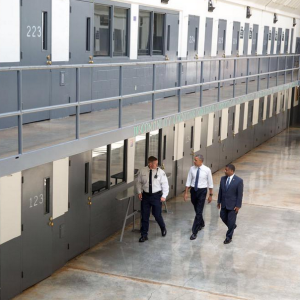If there has been anything positive to come out of a string of recent cases involving African-Americans subjected to abuse by law enforcement authorities, it is that more and more Americans now acknowledge there is a systemic problem with the interplay between minorities and police officers. Too, they acknowledge that something must be done to ease that social tension. President Obama is working to tap into the widely shared desire to create a fairer criminal system and build a more harmonious relationship between the public and police with travels to Oklahoma City, where he became the first sitting president to visit a federal jail, and elsewhere.
Of course, no matter how successful we are in demonstrating that, indeed, “Black lives matter,” we cannot lose sight of the link between economic hopelessness and criminal activity. Freddie Gray’s death at the hands of police officers in Baltimore put a spotlight on the economic despair and hopelessness throughout that city. And where economic prospects are bleak the lure of money through criminal activity looks bright.
Twenty years ago, an innovative public-private partnership injected $130 million into the troubled Sandtown-Winchester/Harlem Park section of Baltimore where Gray lived. Over 1,000 homes were rehabilitated, schools were fixed up, education and health services in the community were bolstered. All that was needed were jobs. But those never materialized. In fact, they continued to vanish. With close to half the residents ages 16-64 unemployed, the number of drug-related arrests per 1,000 tops 150 in this section of Baltimore, among the highest in the city.
It is essential that President Obama continues to focus on the root causes of crime in addition to how it is dealt with by police. His legacy in urban America will ultimately be measured more in economic opportunities created and less in leveling disparities in policing tactics and prison sentences.
Cities like Baltimore, Philadelphia and his hometown of Chicago began losing jobs long before Obama came on the scene and it has been a challenge to recreate the kinds of jobs that can sustain a middle-class existence. Gentrifying a section of a neighborhood or creating art studies in an abandoned factory cannot solve the problem. It is vital to retain and expand the industrial facilities that remain in metropolitan areas and to attract new ones.
In addition, proximity to rail, highway and port operations makes urban areas uniquely suited to establishing new industrial and commercial activities. Of course, this infrastructure must itself be repaired, expanded and rehabilitated in many cases. To President Obama’s credit, he understands the link between infrastructure and economic growth but he’ll need support from Congressional Republicans to move ahead on many of these projects.
What the President might be struggling to reconcile is how the creation of well-paying jobs in the construction of roads and bridges or in operating machinery in industrial facilities bumps up against his ambitious environmental goals. Nowhere is this better illustrated than in the Administration’s plan to reduce the acceptable level of ozone.
At the ground level, we want less of the chemicals that make up ozone and cause smog, especially during the muggy summer months. Fortunately, we’ve made a lot progress on this front in the past few years and a recent poll suggests that more than two-thirds of Americans are pleased with their current air quality. The current standard of 75 parts per billion was established in 2008 and many cities and states are still working to get approval from the Environmental Protection Agency on policies to accurately measure reductions. In addition, hundreds of counties across the country are still not in compliance, but not for lack of trying.
Last fall President Obama announced plans to reduce the acceptable level to 65-70 parts per billion. Given how difficult it has been to implement the 2008 rules, the Administration’s estimate that the new rules would cost only $15 billion a year seems low. Manufacturers and other groups estimate the cost being ten times that amount.
Of course, urban areas, which are often at the upper limit of or above the federally-required ozone level, would likely get hit hardest. Instead of encouraging industrial investment and undertaking infrastructure improvements to lure new businesses, mayors and county officials in metropolitan areas might have to cede these job-creating activities to other locales.
President Obama is the right president at the right time to galvanize the nation’s consciousness surrounding the rampant inequalities in policing and the administration of justice and the need to build a legacy of hope for millions of minorities from coast to coast.
With presidential leadership, as a country we may soon be able to embrace the vision of Dr. King when he said, “Now is the time to make real the promises of democracy. Now is the time to rise from the dark and desolate valley of segregation to the sunlit path of racial justice. Now is the time to open the doors of opportunity to all of God’s children.”

